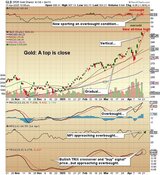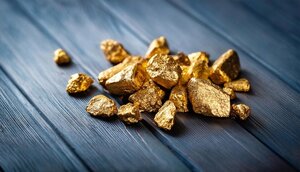Steven Hochberg, chief market analyst at Elliott Wave International, drew a record number of readers and comments with his chart showing a pending countertrend for gold. "Many indicators are confirming that we're in the end stages of the rally that started in 2009. Sentiment is one. Sentiment tends to get very extreme at trend reversal points. It is extremely optimistic at highs and extremely pessimistic at lows. The bears shrink down to almost nothing when you're coming into a rally high. Recently, the bear contingent shrank down to 13.3%, which was the lowest in 27 years."

He concluded: "For the first time in three years, we were able to count a complete declining Elliott Wave pattern from gold's 2011 high. We saw extremes in sentiment that suggested to us the start of an impending gold rally. I think that rally is in its very infancy right now. Ultimately, it's going to carry gold higher. I think gold has upside potential from here."
Shadowstats economist Walter "John" Williams also saw good news for gold in 2015 as part of his hyperinflation forecast for the coming year. "Fundamental economic activity as measured in areas such as retail sales, industrial production, housing starts, payroll numbers and the broadest measure of unemployment—all those numbers are going to deteriorate. The economy is going to head down as we get into reporting in early 2015. Along with that will come renewed expectations of action by the Federal Reserve to accommodate the financial system, particularly the banking system, and the combination of those factors will, I believe, help to trigger a massive decline in the U.S. dollar. As a result of that, we will see spikes in commodity prices, such as oil. We will see a flight to quality in areas such as the precious metals—gold and silver."
Former Federal Reserve Chairman Alan Greenspan also lauded the prospects for gold during a presentation at the New Orleans Investment Conference. "Gold, and to a lesser extent silver, are the only major currencies that don't require a third party credit guarantee. Gold is inbred in human nature. Gold is special. For more than two millennia, gold has had virtually unquestioned acceptance as payment to discharge an obligation. Remember, Germany could not import any goods in the last part of World War II unless it paid in gold.
"Today, China is beginning to convert part of its $4 trillion ($4T) foreign exchange reserve into gold as a partial diversification out of the dollar. Irrespective of whether the yuan is convertible into gold, the status of the Chinese currency could take on unexpected strength in today's fiat money, floating international financial system. It would be a gamble for China to try to buy enough gold bullion to displace the United States' $328 billion of gold reserves as the world's largest holder of monetary gold. But the cost of being wrong, in terms of lost interest and cost of storage, would be quite modest. If China embarks on a gold accumulation program, global gold prices will rise, but only during the period of accumulation."
Joe Foster, fund manager at Van Eck Associates, had a global perspective on the source of downward pressure on the commodities in 2014. "At the beginning of the year, gold was being driven by risk concerns. Investors started worrying about risk when we saw problems in emerging markets like Thailand, Turkey and, eventually, Ukraine. The Chinese economy seemed to be slowing down. It was less of a supply-demand story and more one of people looking at gold as a safe haven and a hedge against some of the risks in the world."
He updated his thoughts in a December note to readers with these insights: "Gold companies are in a better position to operate given lower prices; any significant cut in mining production does not appear imminent. With the stability of the global financial system in question, we believe gold and gold shares may help investors diversify portfolios and preserve value if tail risk becomes a reality."
Jason Mayer, portfolio manager for the Sprott Resource Class Fund, observed in September that "Investors have been reacting in fits and starts, and everyone is still very cautious. I track a number of funds, and I watch how they perform on a day-to-day basis. What I have found interesting is that a number of resource funds in Canada continue to be underweight, particularly in gold equities. I notice they underperform on days that gold stocks have good moves. The generalists out there among the institutional money have little to no presence in various gold equities. For the most part, people have abandoned the space." He predicted that before investors return, they will want to see some upward trajectory. "I don't know if it's going to be a couple of data points that confirm the arrival of an inflationary environment, or the cessation of this disinflationary environment that we've been in since 2009."
Harry Dent, editor of Economy & Markets and Boom and Bust newsletters and author of "The Demographic Cliff," shared his simple strategy for surviving withdrawals from markets on crack. He advised readers to get liquid. "I think gold is extremely oversold right now. People are very bearish on it after the recent fall, but this isn't the time to panic and sell. It is due for a bounce back up to $1,300/oz or even $1,400/oz. That would be the time to lighten up before it goes down again."
Chen Lin, author of What is Chen Buying? What is Chen Selling? newsletter, is also busy doing his homework so he is ready when the market turns, something he sees as inevitable. In the meantime he is focusing on companies that can actually make money at $1,000/oz gold. "One thing for sure is that I sleep well at night holding companies that can flourish even at $1,000/oz. And when the bottom happens, companies with cash will be able to buy out the overleveraged companies," he said.
Bob Moriarty, founder of 321.gold.com, called the current volatility in October when he said: "There is a flock of black swans overhead, any one of which could be catastrophic. The fundamental problems with the world's debt crisis and banking crisis have never been solved. The fundamental issues with the euro have never been solved. The world is a lot closer to the edge of the cliff today than it was back in February." He had some sheltering advice: "The U.S. Dollar Index got irrationally exuberant, and it's due for a crash. When it crashes, it's going to take the stock market with it and perhaps the bond market. If you see QE increase, head for your bunker."
As far back as March, Sprott US Holdings CEO Rick Rule warned about a bumpy ride ahead. "My suspicion is that we have put in lows in the precious metals and they will trade higher, but not straight up. The gains will need to be consolidated. It will be volatile on the way up. The long-term thesis has a lot to do with the increasing ability of the bottom of the demographic pyramid to increase its standard of living, which involves more commodities. I'd say that the great unsung hero of a rebound in the fortune of commodity producers has been the increasingly constrained supply of resources. The demand side on resources has been very slow because this recovery in the West has been a false, paper recovery. It hasn't been accompanied by capital spending or jobs. It's an interest rate-led recovery with flat auto sales and home starts."
On the critical metals front, Simon Moores, manager of data for Industrial Minerals, was optimistic because of the possible impact a Tesla battery Gigafactory could have on demand for graphite, lithium and cobalt, perhaps even copper and aluminum. "Should Tesla choose to use natural flake graphite, the demand for battery-grade material could go up 154%," he said. He advised forward thinking. "If we look at the history of graphite prices, or any commodity for that matter, it's in the times of inactivity that we should be preparing for the next boom. We should try to see where new demand is coming from and identify any supply issues. But most people don't. They usually only act once there's an issue, not before."
Adrian Day Asset Management founder Adrian Day tried to put the gold price in perspective. "Let's not forget where the price of gold was a decade ago: $250/oz. It has done very well to be stuck at $1,200/oz. The number one thing for gold is the dollar, particularly in the near term. The dollar has to turn. Several Fed officials are now expressing concern about the strength of the dollar. If we see several weak economic reports in the next few months, the Fed is going to make noises about continuing to ease. That would push the dollar down and push up the price of gold."
Silver-Investor.com Editor David Morgan got more personal with his advice in October. He pointed out that he is grateful that he is part of the small minority of people on earth who have a portfolio to worry about. "Money is important, but it needs to be put in the proper place. There is more to life than how much money you can make. Nature preaches balance and when things get out of balance, it has a way of bringing them back into equilibrium. This is most evident in the natural resource sector. We're acting as if the earth is income rather than capital. The result is that we are using up our base capital in the form of forests and water and metal and not replacing them. That is unsustainable. I'm afraid we are going to pay a high price for that. We need to live within our means rather than getting all we can. It's more about what you can contribute, maintain and sustain than who has the most toys."
Streetwise Reports/The Gold Report's goal is to provide you with innovative, high quality investing ideas from the top minds in the natural resources space.
Starting in January, The Gold Report will roll out new features focusing on more investing insights, expanded company information and new expert perspectives.
But first we would like to hear from you. How are we doing? What is important to you and your investing future? Let us know. Simply email company president Karen Roche here and tell us what you need to know to be Streetwise in 2015.
Thank you for sharing 2014 with us and all the best in the new year.
Want to read more Gold Report interviews like this? Sign up for our free e-newsletter, and you'll learn when new articles have been published. To see a list of recent interviews with industry analysts and commentators, visit our Streetwise Interviews page.
DISCLOSURE:
1) The interview does not constitute investment advice. Each reader is encouraged to consult with his or her individual financial professional and any action a reader takes as a result of information presented here is his or her own responsibility. By opening this page, each reader accepts and agrees to Streetwise Reports' terms of use and full legal disclaimer.
2) From time to time, Streetwise Reports LLC and its directors, officers, employees or members of their families, as well as persons interviewed for articles and interviews on the site, may have a long or short position in securities mentioned. Directors, officers, employees or members of their families are prohibited from making purchases and/or sales of those securities in the open market or otherwise during the up-to-four-week interval from the time of the interview until after it publishes.








































